 W
WAmerican Chinese cuisine is a style of Chinese cuisine developed by Chinese Americans. The dishes served in many North American Chinese restaurants are adapted to American tastes and often differ significantly from those found in China.
 W
WBrown rice is a whole grain rice with the inedible outer hull removed. White rice is the same grain without the hull, the bran layer, and the cereal germ. Red rice, gold rice, and black rice are all whole rices with differently pigmented outer layers.
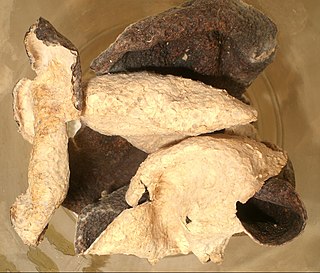 W
WChenpi, chen pi, or chimpi is sun-dried mandarin orange peel used as a traditional seasoning in Chinese cooking and traditional medicine. It is aged by storing them dry. The taste is first slightly sweet, but the aftertaste is pungent and bitter. According to Chinese herbology, its attribute is warm. Chenpi has a common name, ‘ju pi’ or mandarin orange peel.
 W
WA Chinese restaurant is an establishment that serves a Chinese cuisine. Most of them are in the Cantonese style, due to the history of the Chinese diaspora and adapted to local taste preferences, as in the American Chinese cuisine and Canadian Chinese cuisine. The Chinese restaurants in the Netherlands usually combine Cantonese and Indonesian meals on their menu. Chinese takeouts or Chinese takeaways are terms to describe the act of ordering the meal(s) with the intent to eat the food at another location, such as at work or home. It can be found either as a service option of eat-in establishments or as separate establishments.
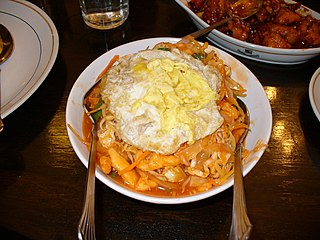 W
WChop suey is a dish in American Chinese cuisine and other forms of overseas Chinese cuisine, consisting of meat and eggs, cooked quickly with vegetables such as bean sprouts, cabbage, and celery and bound in a starch-thickened sauce. It is typically served with rice but can become the Chinese-American form of chow mein with the addition of stir-fried noodles.
 W
WChow mein are Chinese stir-fried noodles with vegetables and sometimes meat or tofu; the name is a romanization of the Taishanese chāu-mèn. The dish is popular throughout the Chinese diaspora and appears on the menus of most Chinese restaurants abroad. It is particularly popular in India, Nepal, the UK, and the US.
 W
WThe chow mein sandwich typically consists of a brown gravy-based chow mein mixture placed between halves of a hamburger-style bun, and is popular on Chinese-American restaurant menus throughout southeastern Massachusetts and parts of neighboring Rhode Island. Originating in Fall River, Massachusetts, in the 1930s or 1940s, the sandwich is not well known outside of a relatively small area of New England.
 W
WCrab Rangoon, sometimes called crab puffs, crab rangoon puffs, or cheese wontons, are filled crisp dumpling appetizers served primarily in American Chinese restaurants.
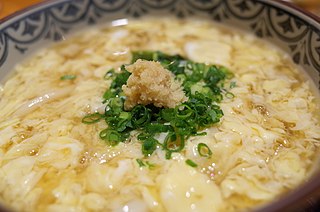 W
WEgg drop soup is a Chinese soup of wispy beaten eggs in chicken broth. Condiments such as black or white pepper, and finely chopped scallions and tofu are optional, but commonly added to the soup. The soup is made by adding a thin stream of beaten eggs to the boiling broth in the final moments of cooking, creating thin, silken strands or flakes of cooked egg that float in the soup.
Egg foo young is an omelette dish found in Chinese Indonesian, British Chinese, and Chinese American cuisine. The name comes from the Cantonese language. Egg foo young is derived from fu yung egg slices, a mainland Chinese recipe from Guangdong.
 W
WEgg rolls are a variety of deep-fried appetizers served in American Chinese restaurants. An egg roll is a cylindrical, savory roll with shredded cabbage, chopped pork, and other fillings inside a thickly-wrapped wheat flour skin, which is fried in hot oil. The dish is served warm, and is usually eaten with the fingers, dipped in duck sauce, soy sauce, plum sauce, or hot mustard, often from a cellophane packet. Egg rolls are a ubiquitous feature of American Chinese cuisine and are often served as free additions to American Chinese combination platters throughout the United States, along with fried rice and fortune cookies.
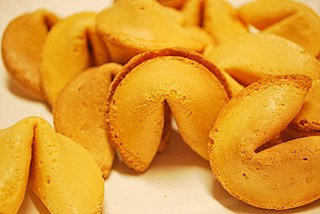 W
WA fortune cookie is a crisp and sugary cookie usually made from flour, sugar, vanilla, and sesame seed oil with a piece of paper inside, a "fortune", usually an aphorism, or a vague prophecy. The message inside may also include a Chinese phrase with translation and/or a list of lucky numbers used by some as lottery numbers; since relatively few distinct messages are printed, in the recorded case where winning numbers happened to be printed, the lottery had an unexpectedly high number of winners sharing a prize.
 W
WHokkien fried rice is a popular Cantonese-style wok fried rice dish in many Chinese restaurants. It has a thick sauce poured and mixed over fried rice with egg. The sauce can include mushrooms, meat, vegetables, etc. Hokkien fried rice is originated in Hong Kong.
 W
WHot and sour soup is a soup from Asian culinary traditions. In all cases, the soup contains ingredients to make it both spicy and sour.
 W
WJiaozi are Chinese dumplings commonly eaten in China and other parts of East Asia. Jiaozi are folded to resemble Chinese sycee and have great cultural significance attached to them within China. Jiaozi are one of the major dishes eaten during the Chinese New Year throughout the entire country and eaten all year round in the northern provinces. Though considered part of Chinese cuisine, jiaozi are popular in other parts of East Asia and in the Western world, where a fried variety is sometimes called potstickers. The English-language term "potsticker" is a calque of the Mandarin word 鍋貼 "guotie". Potsticker was used by Buwei Yang Chao and her husband Yuen Ren Chao in the book How to Cook and Eat in Chinese, which was first published in 1945. In northern China, however, 鍋貼 "guotie" specifically refers to a type of pan-fried jiaozi with its ends left open rather than just any pan-fried jiaozi.
 W
WKowloon Restaurant is a pan-Asian restaurant in Saugus, Massachusetts. The restaurant serves a range of Cantonese, Szechuan, Japanese, Polynesian, and Thai dishes in several themed dining rooms and lounges. Kowloon was called one of the best Chinese restaurants in New England by Boston television station WHDH in 2004.
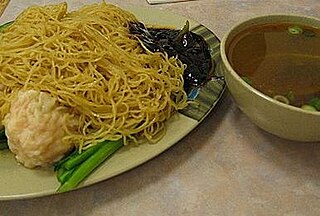 W
WLo mein is a Chinese dish with egg noodles. It often contains vegetables and some type of meat or seafood, usually beef, chicken, pork, or shrimp. It might also be served with wontons although wontons are usually a soup ingredient. It can also be eaten with just vegetables.
 W
WLobster sauce is a type of sauce used in American-Chinese and Canadian-Chinese cuisine. It is also sometimes found in Polynesian-influenced Chinese food. It is a type of "white sauce" within Chinese cooking, meaning that it is of a mild flavour, and based on meat stock, as opposed to soy sauce.
 W
WMein gon or informally referred to as crunchy noodles or crunchy chow mein are a type of noodle-shaped cracker used in American Chinese cuisine.
 W
WMongolian beef is a dish from Taiwan consisting of sliced beef, typically flank steak, usually made with onions. The beef is commonly paired with scallions or mixed vegetables and is often not spicy. The dish is often served over steamed rice, or in the US, over crispy fried cellophane noodles. It is a staple dish of American Chinese restaurants. Despite its name, the dish has nothing to do with Mongolian cuisine.
 W
WMoo shu pork is a dish of northern Chinese origin, possibly originating from Shandong. It is believed to have first appeared on the menus of Chinese restaurants in the United States in the late 1960s, and has since then become a staple of American Chinese cuisine.
 W
WMumbo sauce or mambo sauce is a condiment developed and popularized in Washington, D.C. take-out restaurants, often called "carryouts". The red-orange sauce is similar to barbecue sauce, but somewhat sweeter, and also somewhat spicier or more sour. It is put onto fried chicken wings, french fries, fried jumbo shrimp, and fried rice. The origin and ingredients of Mumbo sauce are subject to great dispute. It is often compared to Chicago mild sauce, found at take-out restaurants in that city’s predominantly Black neighborhoods.
 W
WAn oyster pail is a folded, waxed or plastic coated, paperboard container originally designed to hold oysters. It commonly comes with a handle made of solid wire. Currently, it is often in use by American Chinese cuisine restaurants primarily throughout the United States, to package hot or cold take-out food. It can also sometimes be found in other Western countries, such as Australia, New Zealand, Germany, Poland, England and Brazil, but is rarely seen in China and other Asian countries with high numbers of ethnic Chinese.
 W
WPepper steak is a stir-fried Chinese American dish consisting of sliced beef steak cooked with sliced bell peppers, bamboo shoots and other seasonings such as soy sauce and ginger, and usually thickened with cornstarch. Sliced onions and bean sprouts are also frequent additions to the recipe.
 W
WA pu pu platter, pu-pu platter, or pupu platter, is a tray of American Chinese or Hawaiian food consisting of an assortment of small meat and seafood appetizers. A typical pupu platter, as found in American Chinese cuisine, might include an egg roll, spare ribs, chicken wings, chicken fingers, beef teriyaki, skewered beef, fried wontons, fried shrimp, crab rangoon and things of that nature, accompanied by a small hibachi grill.
 W
WPuerto Rican Chinese cuisine is a popular style of food exclusive to restaurants in Puerto Rico developed by its Chinese immigrants. The food is a variation of Cantonese cuisine with some elements of Puerto Rican cuisine. A typical dish consists of fried rice, a choice of meat, and French fries. The fried rice itself varies in every restaurant, but can contain many ingredients such as ham, beef, shrimp, egg, lettuce, and onions. In 2020, there were an estimated 450 Chinese restaurants in Puerto Rico and the owners suffered discrimination during the COVID-19 pandemic in Puerto Rico.
 W
WSha cha beef is the name of a Chinese dish featuring shacha sauce and tenderized beef strips. The Americanized dish is usually served over a bed of white rice with fresh scallions and cilantro (coriander). This dish is native to the Gansu province of China.
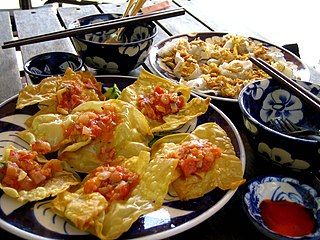 W
WShrimp toast or prawn toast is a Hongkongese-Cantonese dim sum dish. It is made from small triangles of bread, coated with a paste made from minced shrimp and cooked by baking or deep frying. It is a common appetizer in Western Chinese cuisine such as Australian and American. A common variant in the United Kingdom, Australia and Ireland is sesame prawn toast. This involves sprinkling sesame seeds before the baking or deep frying process.
 W
WSingapore-style noodles is a dish of stir-fried cooked rice vermicelli, curry powder, vegetables, scrambled eggs and meat, most commonly chicken, beef, char siu pork, or prawns, yellow in colour. Singapore noodles are a Cantonese creation, and are very common in Cantonese-style restaurants and take away eateries in Hong Kong. The dish is now a very popular dish in Chinese restaurants and takeaways operated in various countries.
 W
WSiu mei is the generic Cantonese name of meats roasted on spits over an open fire or a large wood-burning rotisserie oven. It creates a unique, deep barbecue flavor and the roast is usually coated with a flavorful sauce before roasting. Siu mei is very popular in Hong Kong and Macau, and overseas Chinatowns especially with Cantonese emigrants. In Hong Kong, the average person eats siu mei once every four days, with char siu being the most popular, followed by siu yuk in second, and roast goose being third. Siu mei is also known colloquially as siu laap, as the latter term encompasses siu mei, lou mei, and other Cantonese-style cooked and preserved meats.
 W
WSpare ribs are a variety of ribs cut from the lower portion of a pig, specifically the belly and breastbone, behind the shoulder, and include 11 to 13 long bones. There is a covering of meat on top of the bones and also between them. Spare ribs (pork) are distinguished from short ribs, which are beef.
 W
WSpring rolls are a large variety of filled, rolled appetizers or dim sum found in East Asian, Southeast Asian cuisine. The name is a literal translation of the Chinese chūn juǎn. The kind of wrapper, fillings, and cooking technique used, as well as the name, vary considerably within this large area, depending on the region's culture.
 W
WHuy Fong's sriracha sauce Vietnamese: Tương Ớt Sriracha), also referred to as sriracha or rooster sauce for the rooster on its label, is a brand of sriracha, a chili sauce that originated in Thailand. The sauce is produced by Huy Fong Foods, a California manufacturer, and was created in 1980 by David Tran, a Chinese immigrant from Vietnam. Some cookbooks include recipes using it as their main condiment.
 W
WThe St. Paul sandwich can be found in many Chinese American restaurants in St. Louis, Missouri, as well as other cities in Missouri, including Columbia, Jefferson City, and Springfield. The sandwich consists of an egg foo young patty served with dill pickle slices, white onion, mayonnaise, and lettuce between two slices of white bread. The St. Paul sandwich also comes in different combinations and specials, such as chicken, pork, shrimp, beef, and other varieties.
 W
WSubgum or sub gum is a type of Chinese dish in which one or more meats or seafood are mixed with vegetables and sometimes also noodles, rice, or soup. It originates from Cantonese cuisine and is a commonly encountered dish on the menus of Chinese restaurants in North America.
 W
WSweet and sour is a generic term that originated from Chinese cuisine and encompasses many styles of sauce, cuisine and cooking methods. The etymology of the term "Sweet and Sour" comes from the Chinese word "甜酸"(甜 = sweet, 酸 = sour), formally used in Chinese dishes as "糖醋“. It is commonly used in China since the Tang Dynasty (618-907), East Asia, Southeast Asia, and has been used in England since the Middle Ages. Sweet and sour remains popular in Europe and the Americas.
 W
WWahoo's Fish Taco is a U.S.-based restaurant chain that offers Mexican food mixed with Brazilian and Asian flavors. Categorized as a "fast casual restaurant", the quality and preparation time of its food is between that of a fast-food restaurant and a more formal restaurant. Wahoo's provides many vegetarian and some vegan options, such as tofu, banzai veggies and brown rice, and also provides a kids' meal menu. They serve Wahoo fish in their tacos, as well as Mahi-mahi.
 W
WYaka mein is a type of beef noodle soup found in many Creole restaurants in New Orleans. It is also a type of Chinese wheat noodle.
 W
WYangzhou fried rice is a popular Chinese-style wok fried rice dish in many Chinese restaurants throughout the world. It is commonly sold in the UK as special fried rice and in the US as house special fried rice.